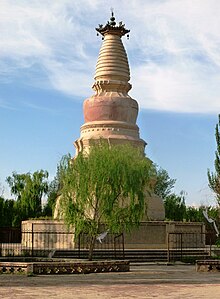| White Horse Pagoda, Dunhuang | |
|---|---|
 White Horse Pagoda | |
| Religion | |
| Affiliation | Mahayana Buddhism |
| Location | |
| Location | Dunhuang, Gansu Province, China |
| Country | China |
| Architecture | |
| Completed | circa 384 CE |
40°07′50.85″N 94°38′54.79″E / 40.1307917°N 94.6485528°E
The White Horse Pagoda (simplified Chinese: 白马寺; traditional Chinese: 白馬寺; pinyin: Báimǎ Sì, Wade-Giles: Paima szu), in Dunhuang, Gansu, China, was built to commemorate Tianliu, the white horse of the Buddhist monk Kumārajīva, which carried Buddhist scriptures all the way from Kucha to Dunhuang in China c. 384 CE.[1]
The pagoda is located about 2 km southwest of the centre of Dunhuang city. It was repaired in the Daoguang era (1821-1851) and again in 1992. It is 12 metres (39 feet) high and 7 metres (23 feet) in diameter and consists of 9 levels in total. The exterior is built of adobe bricks and is filled with grass and mud mixed with lime. The base is in the form of an eight-spoked wheel, the 1st level has four sides, while levels 2 to 4 have folding corners, the 5th level is decorated with upturned lotuses, the 6th is in the shape of an overturned bowl, the 7th level is wheel-shaped, while the 8th level has a hexagonal plate at the top of the pagoda with big wind-bells hanging on every corner.[2] Above that are three metal balls surmounted by a trident. Local people say the chime of the bells are an echo of the neighing of the horse.